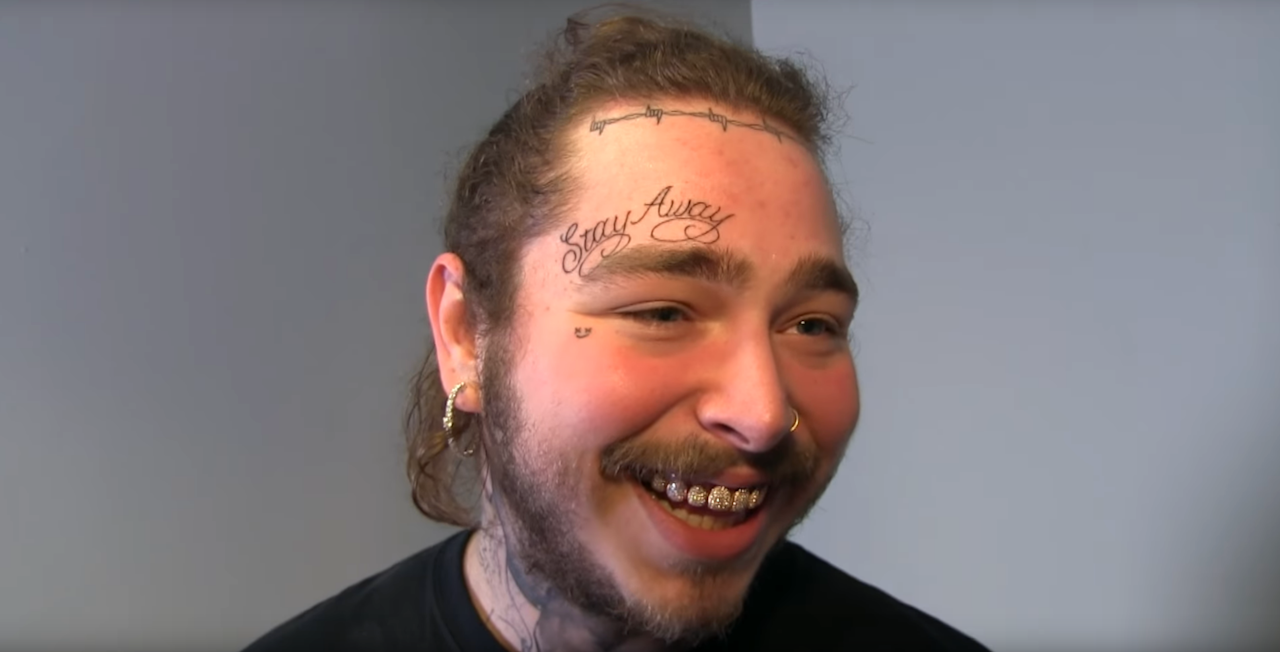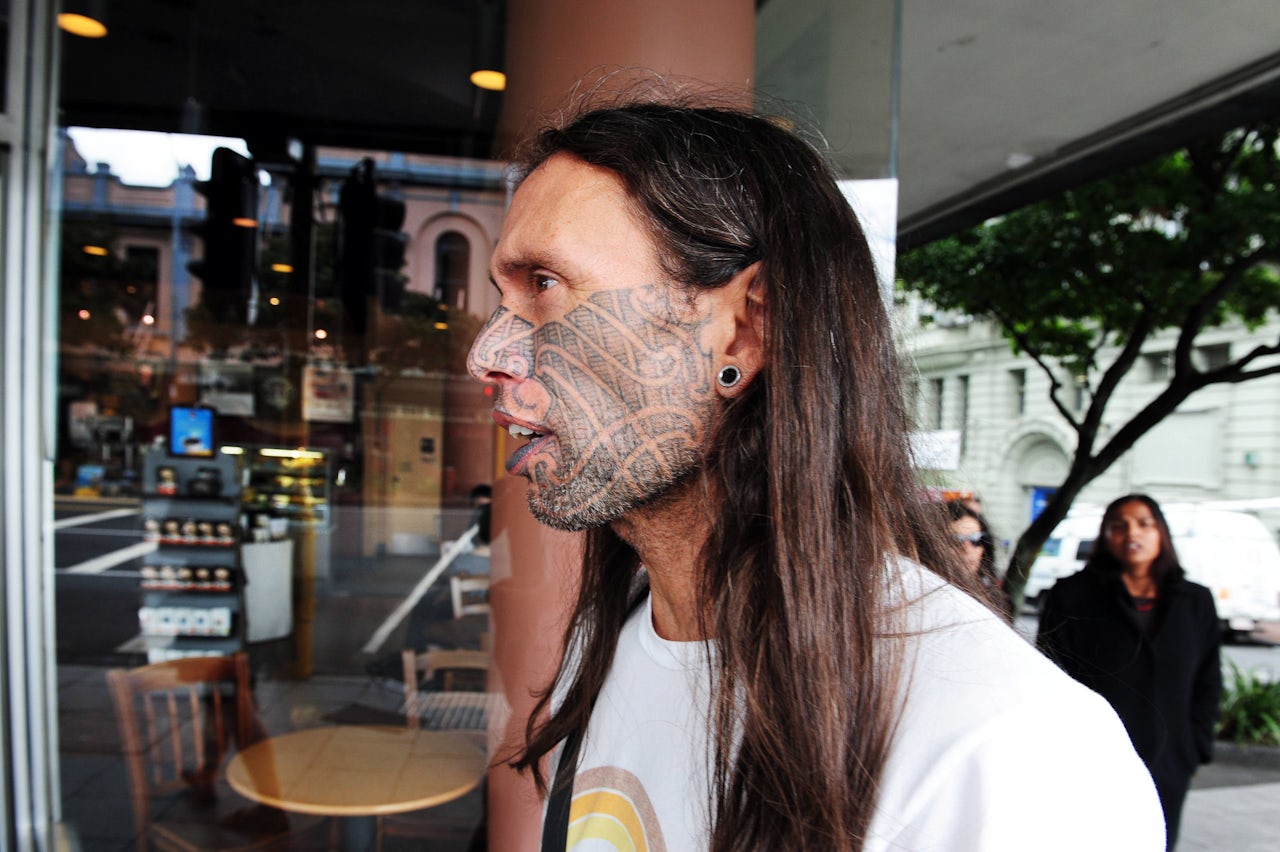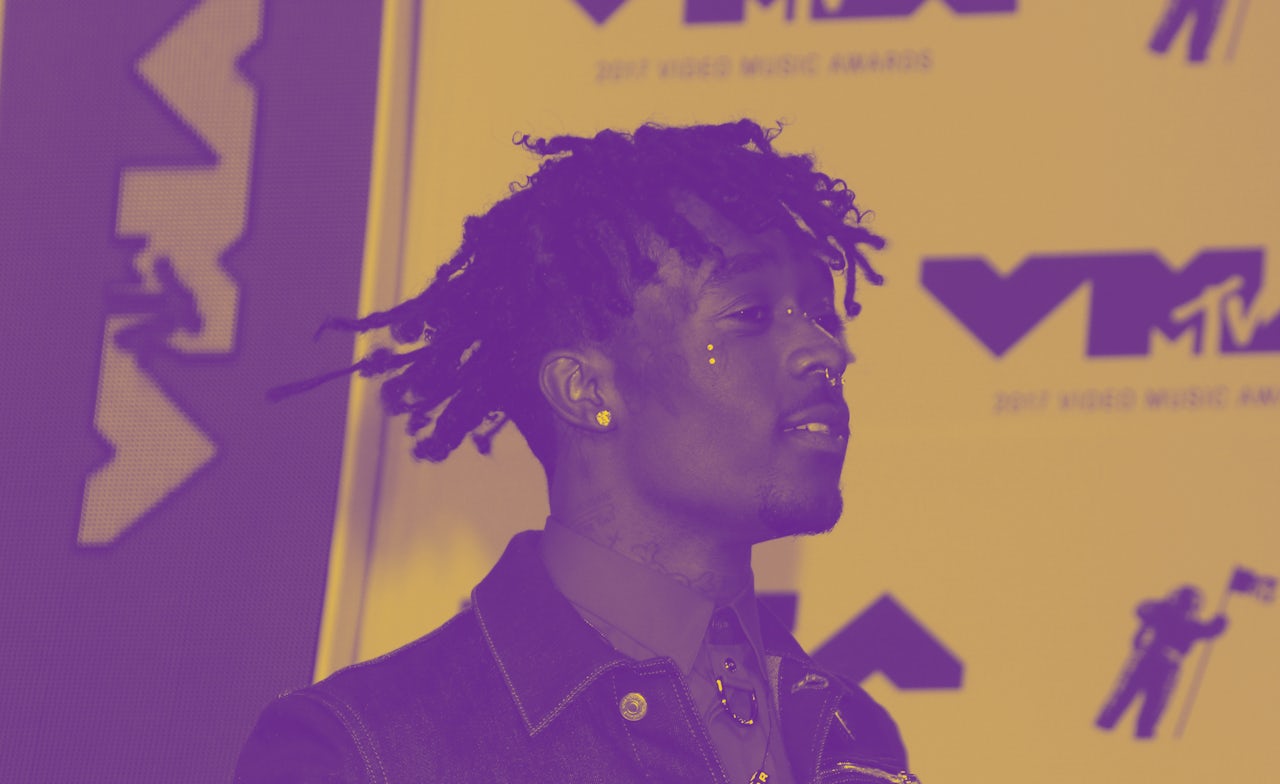Few things suggest you should stay away from a person more than Post Malone’s forehead tattoo, which literally reads “STAY AWAY.” And yet, the sign seems to have backfired for the rapper, who garnered himself even more attention than he already had when he got the ink and then explained it away by saying, “I kind of just wanted to, I don’t know, piss my mom off.” The “White Iverson” scribe is part of a generation of rappers with visages that look like the doodles on the back of a middle schooler’s notebook. Prominent examples include the late Lil Peep, who had “CryBaby” scrawled in a large font above his right eyebrow (After Peep’s death, Post Malone got a tattoo of his face, “CryBaby” included); 21 Savage, whose clarification to an interview question about the knife on his forehead launched a meme that eventually spawned his album title; the late Fredo Santana, with his Manson-esque forehead cross; and the Chucky-esque Tekashi 6ix9ine, whose face is covered in “69” tattoos.
To outsiders — or like, most people over 23 — the desire to mar one’s face with the number for simultaneous reciprocated oral sex is baffling. But haven’t slightly older people always felt this way about the kids coming up? Social mores are constantly being adjusted, taboos being lifted, and the once unthinkable being rendered mainstream in surprisingly short periods of time. This holds for serious political issues like gay marriage and marijuana legalization, but it also goes for matters of style. My grandfather once made my dad go back because the barber didn’t cut his hair short enough; such a vigilant attitude towards boy’s hair length seems remarkably antiquated today. Perhaps face tattoos are on the cusp of becoming the new normal, and my nephew’s cheek will one day say “cardiofuck.”
That face tattoos could go mainstream seems unlikely, but strange fashion swings have happened before. It’s hard to think of a clothing item that’s more ubiquitous than the T-shirt, but the humble cotton garment hasn’t always been omnipresent. For the first century or so of its existence, it basically functioned as underwear — something for laborers and military personnel to wear under their uniforms. Going outside without a proper shirt on top was even illegal in some places, according to this Gizmodo article. Then Marlon Brando donned a T-shirt to sweat across the stage and screen in A Streetcar Named Desire, unintentionally inspiring a boom in sales. Since then, T has been the default shirt shape for generations of casual, comfortable people.
For “things that seem ridiculous or eccentric [to go mainstream], it takes someone who has exceptional taste giving them their blessing,” Rachel Seville Tashjian, the fashion features editor at the style publication Garage, tells me. She recalled the recent example of the Balenciaga Triple S, a “hideous on purpose” New Balance-esque sneaker. “Everyone thought of them as going a little too far. Then A$AP Rocky [wore them] on the cover of GQ Style three months ago and said, ‘I call them the Larry Davids, you feel me?’” To Tashjian’s point, ever since Rocky’s co-sign, I’ve been barraged with Instagram ads for Triple S knockoffs billing themselves as “Balencia [sic] dad shoes.”
Granted, face tattoos are different than clothes. “The problem with face tattoos is there is no coming back from one after the fashion trends change,” says Kevin Paul, a British tattooer known in part for his work with Ed Sheeran. “Having face tattoos myself, I know how people look at you and judge you differently. I personally wouldn’t have it done if I could go back again.”
“I can definitely tell you that if Rihanna did it, then face tattoos would become status quo within a year.”
Phil Marandola, marketing manager at The Finery, a tattoo removal service with locations in five Northeastern states, says that while it might be more common to see the errant face tattoo these days, he believes that’s simply a function of tattoos in general being more prevalent. “If ten years ago, a given percentage of people who were tattooed had face tattoos, I think that same percentage of people have them now. There’s just so many more people getting tattooed.” This is in contrast to hands and neck tattoos, which he says were once mostly for people already covered in ink but are now increasingly popular among office types. The Finery has a community service program that offers free hand, neck, and face tattoo removal for ex–gang members and people who have been incarcerated. “We see the majority of face tattoos in that program,�� he says.
Sara Antoinette, an artist who works at Brooklyn Tattoo, says she mostly gives face tattoos to longtime customers who already have art on their hands and neck, not to mention the rest of their bodies. She says that Brooklyn Tattoo doesn’t often get customers “who just walk in and don’t have any tattoos and want a random face tattoo,” and that they’d shy away from giving one in that situation. “Personally, I don’t think it looks good when somebody doesn’t have a whole lot of tattoos and just has their neck and hands and face tattooed.” (There is one exception, which both Marandola and Antoinette point out: cosmetic tattoos — permanent makeup, essentially — are already widespread. But perpetually enhanced eyebrows are far from what most people imagine when they picture a face tattoo.)
This is something I heard repeatedly: hand, neck, and especially face tattoos have traditionally been the final frontier for people who have undergone decades of tattoo work and have nowhere else to put new ink. Skipping straight to face tattoos is frowned upon, almost like a violation of tattoo code. Says Paul, “As artists, we have a responsibility to educate clients on the long term of getting tattooed and the risk from following tattoo trends. The sad thing is most artists now just want their money and will stick anything on anybody as long as they’re getting paid.”
However, face tattoos haven’t always held the same weight in every culture. We might associate them with a certain drug-addled nihilism these days, and it’s true that convicts in ancient Rome and China were given face tattoos which marked them as prisoners. But in other times and places they’ve been a symbol of social status or even taken on a religious significance. The most prominent of these is the tā moko, a rite of passage among the indigenous Maori people of New Zealand. (While the most famous person with the tā moko is probably Mike Tyson, it’s important to note that tattooing the tā moko on non-Maori is generally seen as offensive.)
I spoke with Te Kanawa, a Maori artist at Otautahi Tattoo in Auckland, who says that, “In times of old, anything that was on your face was to let people know what your skills were, where you came from, or what sort of rank you hold within your tribe or your family. It was almost similar to a C.V.” These elaborate designs were banned in the early 20th century. In recent years, there’s been a resurgence linked to a movement to reclaim cultural identity. “For a while you had a lot of gang members that would wear [tā moko]. Even though they used it for intimidation, they were the ones that kept it alive. We almost lost the whole art form. Because of them, it stuck around. Now it’s becoming more acceptable. You have lawyers, judges, politicians that have tā moko facial tattoos.” Te Kanawa tells me that he sees a parallel between the acceptance of tā moko tattoos and the general acceptance of the sort of face tattoos that rappers get. “I think it’s becoming a lot more mainstream now because it’s seen as artwork. There was a time when artwork would only be hung in galleries and in museums,” but increasingly, tattoos are given a similar respect.
Professor Ken Gelder, whose book Subcultures: Cultural Histories and Social Practice contains a chapter on the subject, traces the modern development of western tattooing to sailors who were influenced by Maori and other indigenous groups in the Pacific. “Nautical people took on these influences; but the nautical world developed its own tattoo traditions too, and so did the prison world,” he says. But among most westerners today, “tattooing is a ‘lifestyle’ thing, driven by choice, memory, nostalgia, experimentation, family, etc.” Most people prefer to be able to cover their tattoos when it’s convenient, so he doesn’t see any reason to think they could become respectable or mainstream. “[The face] remains at the far end of full body tattooing — the last stop, as it were — and in any case is not for the faint hearted. The sheer visibility of face tattoos makes it difficult to see much evidence of broader social acceptance, even among tattoo devotees.”
Kanawa’s comments made me realize that, rather than treating the new crop of face tattoos as an aberration, there’s an argument to be made that they’re a return to tattooing’s roots. They might not have the cultural value of the Maori tā moko, but don’t SoundCloud rappers’ tattoos also function like a walking C.V. — a way to broadcast to the world what they, as rappers, care about? Peep’s “CryBaby” encapsulated his entire persona. Post Malone wants people to know he has an ambiguous relationship towards fame, or at least that he knows who Nirvana is. 21 Savage raps like a guy with a dull knife on his forehead, and Lil Pump raps like a guy with a rocket below his right eye. Broadcasting one’s résumé on one’s face is definitely a way to get noticed, but will non-famous people adopt the practice? Or, to put it another way: Could someone like Lil Pump do for face tattoos what pre-bloat Marlon Brando did for T-shirts?
Rachel Seville Tashjian of Garage says that in her opinion, face tattoos haven’t found a champion ubiquitous enough to normalize them in the eyes of the masses. So what would it take for the face tattoo to truly become socially acceptable? Immediately, she says, “I can definitely tell you that if Rihanna did it, then face tattoos would become status quo within a year.”




